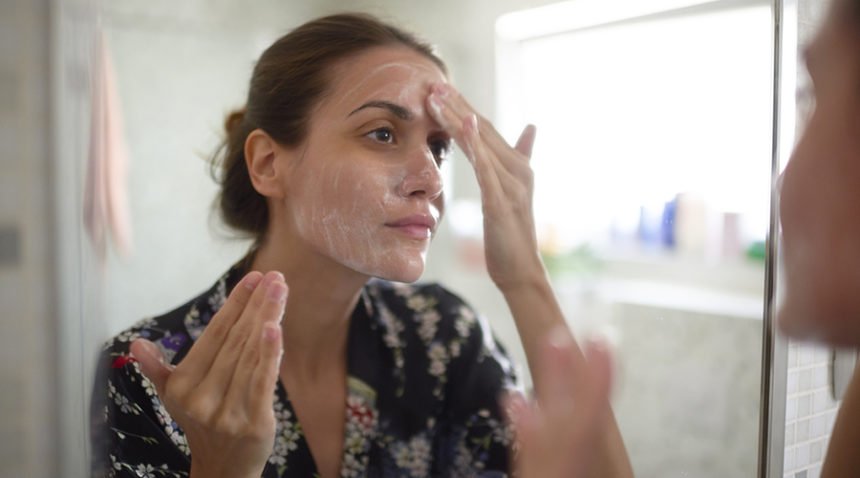We know one of the best ways to protect yourself and others from coronavirus disease 2019 (COVID-19) is to wear a mask. But doing so may have one unintended consequence—mask-related acne, often called maskne.
These tiny bumps around the mouth, nose and eyes are a common side effect that is usually the result of clogged pores.
“The mask blocks the pores, which can then result in increased oil, inflammation and bacteria,” says UNC Health dermatologist Heather Holahan, MD.
Sebaceous glands are small, oil-producing glands in your skin that are attached to hair follicles. As oils and bacteria build up and block your pores, it can lead to acne or skin irritation—especially when those pore-cloggers are blocked by a mask.
“We have seen this (mask-related acne) in athletes who wear football helmets and protective equipment such as chin straps,” Dr. Holahan says. “So it’s not new. It’s just we’re seeing it in much larger numbers because now everyone should be wearing a mask.”
So how can you wear a mask to help prevent the spread of COVID-19 and still avoid maskne? Dr. Holahan offers these six tips.
1. Make sure your face is clean before you put on a mask.
Wash your face when you wake up and again before you go to bed. Clean it more often if you exercise, work up a sweat or wear your mask all day.
“To remove the accumulation of any oil and bacteria, you can use an over-the-counter, gentle balancing cleanser. If you are more acne-prone, find a cleanser with 2 to 3 percent salicylic acid in it,” Dr. Holahan says.
While having a clean face is important, avoid scrubbing your face using a harsh exfoliator, because that’s going to create more irritation.
“When you create that irritation, you can flare or create more acne,” Dr. Holahan says.
If you have sensitive skin, talk to a dermatologist about the best type of medicated cleanser for your skin.
2. Wear moisturizer.
After you wash your face, it’s important to put a moisturizer on. Moisturizer acts as a barrier between your mask and your skin.
“The moisturizer adds a layer of protection,” Dr. Holahan says.
To best decide on the most appropriate moisturizer for you, it is important to determine if your skin is more on the dry side, more oily or a combination of the two. If your skin is more oily, then a gel moisturizer may be best. For acne-prone skin, find an oil-free moisturizer.
3. Change and wash your mask regularly.
Make sure your mask fits well and is not too tight. And if you’re someone who sweats often or has more oily skin, consider changing your mask halfway through the day, Dr. Holahan says.
If you’re using a fabric mask, wash it after each use with a gentle detergent. Avoid bleaching the fabric, as this can cause irritation to the skin, Dr. Holahan says.
You can wash your mask in a washing machine and dry it in the dryer, like any clothing item.
4. Try a different type of mask.
If your mask is irritating your skin, try one made out of an alternative material. So if you’re using a surgical mask, try a fabric mask.
“Cotton is probably the least reactive of the fabric masks,” Dr. Holahan says.
5. Don’t try a bunch of acne-fighting products at the same time.
If you’re developing acne, the tendency is to want to use several products on your skin to nip it in the bud.
“I totally understand this, because we equate ‘more’ with increased ‘efficacy,’ but this behavior can actually contribute further to irritation,” Dr. Holahan says.
Find one product and try that for a few weeks before trying something else.
“And if you’re using a strong cream at night such as one that contains a retinoid, consider stopping use or a decrease in frequency, as these may contribute to the inflammation,” Dr. Holahan says.
Instead, consider over-the-counter benzoyl peroxide for spot treatment on pimples. Or you may need a topical antibiotic ointment prescribed by a doctor. But apply these at night, not under your mask.
“Avoid putting medicines or creams such as benzoyl peroxide under the mask, as blocking or covering the substance on the skin can heighten its effects,” Dr. Holahan says.
6. Reach out to your doctor.
It’s fine to try a couple of over-the-counter remedies at home, but if your maskne is not getting better, see a doctor.
“We can often use hormonal therapies, such as oral contraceptives and/or a medication called spironolactone for the management of acne in women,” Dr. Holahan says. “Additionally, in some patients, we decide to start an oral antibiotic to help gain control of the inflammation that has not responded to over-the-counter medicine.”
Whatever you do, don’t stop wearing your mask.
“Reach out to a doctor for an in-person or virtual visit rather than avoiding wearing a mask,” Dr. Holahan says. “I understand if you’re breaking out like crazy, the tendency is to want to avoid wearing the mask. But we need to wear the masks right now, so it’s a good idea to reach out to a doctor to help you.”
If you are experiencing any type of skin irritation, contact your dermatologist. If you don’t have one, you can find one here.

